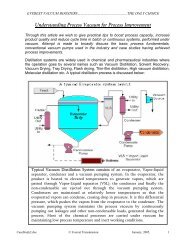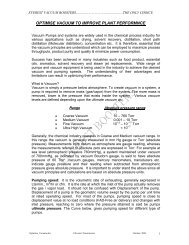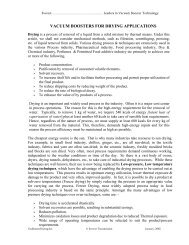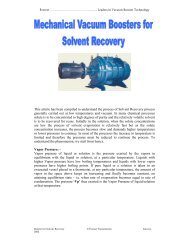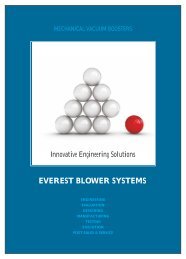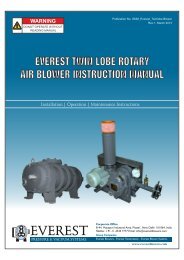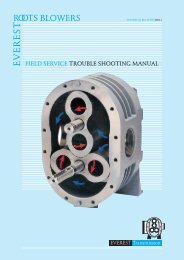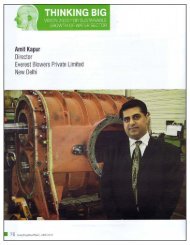WARNING
Operation & Maintenance Manual - Everest Blowers
Operation & Maintenance Manual - Everest Blowers
- No tags were found...
Create successful ePaper yourself
Turn your PDF publications into a flip-book with our unique Google optimized e-Paper software.
<strong>WARNING</strong><br />
DONOT OPERATE WITHOUT<br />
READING MANUAL<br />
Publication No. OMM_Everest_Trilobe Blower<br />
Rev 1, March 2013
Instruction Manual<br />
CONTENTS<br />
Index<br />
Pg. No.<br />
To Get The Most From Your Everest Blower<br />
Safety Precautions<br />
Working Principle<br />
Introduction - Your Key To Trouble Free Service<br />
Equipment Check & Storage<br />
2<br />
3<br />
4<br />
5<br />
6<br />
Installation 7<br />
Cross Sectional View 8<br />
Bill Of Material 9<br />
Drive Installation 10<br />
Recommended Layout For Multiple Blowers Installation 11<br />
Auxiliary Equipment 12<br />
Accessories Layout For Everest Blowers 15<br />
Lubrication 16<br />
Blower Startup Checklist 18<br />
Trouble Shooting<br />
Fault Chart<br />
Everest Wants To Know What You Think - Feedback Form<br />
Notes<br />
19<br />
20<br />
21<br />
24<br />
© Everest Blowers www.everestblowers.com 1
Instruction Manual<br />
TO GET THE MOST FROM YOUR “EVEREST” BLOWER<br />
1.0 Make sure proper oil levels are maintained in the gear end and grease/oil in the<br />
bearing end.<br />
2.0 Check oil level and grease every 40 hours of operation. Loss of oil or grease<br />
should be replenished.<br />
3.0 First oil change should be done within the first 100 operating hours and thereafter<br />
every 1000 hours or more often, if oil gets dirty.<br />
4.0 Check belt tension every fortnight. Too tight belts would cause premature bearing<br />
failure while too loose belts would cause overheating of belts and pulleys.<br />
5.0 Check regularly for any knocking or abnormal sound. High frequency sound<br />
indicates bearing trouble. Knocking sound indicates rotor timing upset. Contact<br />
“Everest” for necessary adjustments.<br />
6.0 Clean air filter every fortnight by reverse airflow. Chocked filter would result in<br />
excessive power consumption and overheating of blower. Replace filter every<br />
three months or earlier.<br />
7.0 Check and clean air silencer every month.<br />
CAUTION<br />
Ÿ Everest Blower is shipped without oil.<br />
Ÿ Before operating, put the required amount of oil into the reservoirs as<br />
per instructions under lubrication.<br />
Ÿ Do not fill oil reservoirs until blower is mounted in its operating location.<br />
NOTICE<br />
Ÿ<br />
Everest Blowers are meant for indoor installation or should be protected<br />
from direct rain and sunlight, if installed outdoor.<br />
© Everest Blowers www.everestblowers.com<br />
2
Instruction Manual<br />
SAFETY PRECAUTIONS<br />
Safety is everybody’s business and is based on your good use of common sense. All situations or<br />
circumstances cannot always be predicted and covered by established rules. Therefore, use your<br />
past experience, watch out safety hazards and be cautious. Some general safety precautions are<br />
given below.<br />
DANGER<br />
Failure to observe these notices could result in injury or death of personal.<br />
Ÿ<br />
Ÿ<br />
Ÿ<br />
Ÿ<br />
Ÿ<br />
Ÿ<br />
Keep fingers and clothing away from blower inlet and discharge ports, revolving belts,<br />
pulleys, drive coupling etc.<br />
Do not use the air discharged from this unit for breathing - not suitable for human<br />
consumption.<br />
Do not loosen or remove the oil filter plug, drain plugs, covers or break any<br />
connections, etc., in the air or oil system until the unit is shut down and the air pressure<br />
has been relieved.<br />
Electric shock can and may be fatal.<br />
Open main, disconnect switch, tag and lockout before working on the control.<br />
Disconnect the Blower unit from its power source, tag and lockout before working on<br />
the Unit.<br />
<strong>WARNING</strong><br />
Failure to observe these notices could result in damage to equipment.<br />
Ÿ<br />
Ÿ<br />
Ÿ<br />
Stop the unit if any repairs or adjustments on or around the Blower are required.<br />
Disconnect the Blower unit from its power source, tag and lockout before working on<br />
the unit.<br />
Do not operate unit if safety devices are not operating properly. Check periodically.<br />
Avoid bypassing safety devices.<br />
©Everest Blowers<br />
www.everestblowers.com<br />
3
Instruction Manual<br />
WORKING PRINCIPLE<br />
POSITION-1 POSITION-2 POSITION-3 POSITION-4<br />
Everest Tri-lobe Rotary Compressors/Blowers are positive displacement units, whose pumping<br />
capacity is determined by size, operating speed and pressure conditions. It employs two Tri-lobe<br />
impellers mounted on parallel shafts, rotating in opposite direction within a casing closed at the ends<br />
by side plates. As the impellers rotate, air is drawn into one side of the casing and forced out of the<br />
opposite side against the existing pressures. The differential pressure developed, therefore, depends<br />
upon the resistance of the connected system. The Blowers, being positive displacement type, do not<br />
develop pressure within the casing but the discharge pressure depends upon the system resistance /<br />
back pressure. Effective sealing of the compressor inlet area from the discharge area is accomplished<br />
by use of very small operational clearance, eliminating the need of any internal lubrication of the lobes.<br />
A pair of accurately machined alloy steel, hardened and ground timing gears maintain clearances<br />
between the impellers, during rotation. The air, thus delivered, is 100% OIL FREE<br />
The pumping capacity of a lobe compressor, operating at constant speed remains relatively<br />
independent of inlet and discharge pressure variations. These Blowers are constant volume<br />
machines, which deliver a fixed discharge against the system back pressure. It is, therefore, essential<br />
to ensure that minimum pipeline restrictions, at the inlet and discharge, are imposed.<br />
Adequate size piping and large radius bends ensure minimum line losses resulting in higher efficiency<br />
and low power consumption. Sudden change in pipeline cross section should also be avoided.<br />
To change capacity, it is necessary either to change speed (energy saving) or vent some of the air into<br />
atmosphere (not energy saving). The air must not be recirculated from the discharge to suction as it<br />
may result in over heating. No attempt should ever be made to control the capacity of compressor by<br />
means of throttle valves in the intake or discharge piping. This increases the power load on the motor<br />
and may seriously damage the compressor. There is an increase in the discharge air temperature due<br />
to heat of compression. As a thumb rule the discharge air temperature increases @ 10 C for every 0.1<br />
2<br />
Kg/cm of<br />
P above the inlet temperature.<br />
©Everest Blowers<br />
www.everestblowers.com<br />
4
Instruction Manual<br />
INTRODUCTION - YOUR KEY TO TROUBLE FREE SERVICE<br />
Thank you for investing in Everest quality. The Everest reputation for rugged dependability has been<br />
earned by over 30 years of service in demanding, industrial operations where downtime cannot be<br />
tolerated and efficient blower performance is expected. Your Everest Blower is a precision-engineered<br />
blower that has been carefully manufactured and thoroughly tested at the state-of-the-art Everest<br />
Blowers factory.<br />
As with other precision machinery, there are several relatively simple installation, operation and<br />
maintenance procedures that you must observe for optimum blower performance. There is no<br />
guesswork in the manufacture of your highly advanced Everest Blower and there must be none in<br />
preparing the Blower to get the job done in the field.<br />
The purpose of this manual is to help you properly install, operate and maintain your Everest Blower. It<br />
is essential that you review all sections of this manual in preparation for installing your blower. Follow<br />
the instructions carefully and you will be rewarded with trouble free Everest service................year in<br />
and year out.<br />
WHERE TO CALL FOR EVEREST BLOWER ASSISTANCE:<br />
For prompt professional Everest service always contact your authorized Everest Distributor First. If<br />
you do not know your authorized Everest Distributor, contact the numbers below for immediate<br />
assistance.<br />
EVEREST CUSTOMER SERVICE / FACTORY SERVICE DEPARTMENT<br />
EVEREST BLOWERS PVT. LTD.<br />
B-44 MAYAPURI INDUSTRIAL AREA, PHASE - 1,<br />
NEW DELHI - 110064, INDIA.<br />
Ph : 91 - 11 - 45457777 | Fax: 91-11-45457718<br />
Email : info@everestblowers.com<br />
© Everest Blowers www.everestblowers.com<br />
5
Instruction Manual<br />
EQUIPMENT CHECK & STORAGE<br />
EQUIPMENT CHECK:<br />
On uncrating, check the packing slip carefully to be sure all the parts have been received. All<br />
accessories are listed as separate items on the packing slip, and small important accessories such as<br />
relief valves, can be overlooked or lost. After every item on the packing slip has been checked off,<br />
unpack carefully. Register a claim with the carrier for lost or damaged equipment.<br />
<strong>WARNING</strong><br />
Customers are cautioned to provide adequate protection, warning and safety<br />
equipment necessary to protect personnel against hazards involved in<br />
installation and operation of this equipment in the system or facility.<br />
STORAGE:<br />
Your Everest Blower was packed at the factory with adequate protection to permit normal storage for<br />
upto three (3) months. If the unit is to be stored under adverse conditions or extended period of time,<br />
the following additional measures should be taken to prevent damage.<br />
1 Store the Blower in a clean, dry area.<br />
2 Make certain inlet and discharge air ports are tightly covered to prevent foreign material from<br />
entering the air box.<br />
3 All exposed, non-painted surfaces should be protected against rust and corrosion.<br />
4 Provide adequate protection to avoid accidental /mechanical damage.<br />
5 In high humidity or corrosive environments, additional measures may be required to prevent<br />
rusting of the Blower internal surfaces.<br />
6 To prevent rusting of gears, bearings etc., the oil reservoirs may be filled with normal operating<br />
oil.<br />
7 Rotate the Blower shaft (10 to 25 turns) monthly during storage. Inspect the Blower shaft<br />
(near shaft seal area) monthly and spray with rust inhibitor if needed.<br />
8 For long-term storage (over six (6) months) contact Everest Customer Care for<br />
recommendations.<br />
REMOVING PROTECTIVE MATERIALS:<br />
The shaft extension is protected with rust inhibitor that can be removed with any standard solvent.<br />
Alternatively the Blower pulley is factory fitted on the shaft extension and it requires no cleaning.<br />
Blower inlet & outlet are temporarily capped to keep out dirt and other contaminants during shipment.<br />
These covers must be removed before start-up. Keep them intact during the period of storage.<br />
© Everest Blowers www.everestblowers.com<br />
6
Instruction Manual<br />
Everest Blowers are internally and externally treated to protect against normal atmospheric corrosion.<br />
Prior to installation remove covers from Blower inlet and discharge openings and inspect internals. If<br />
the cleaning is required, clean the internals throughly using any commercial solvent (e.g. Kerosene).<br />
Continue this procedure until the unit is visibly clean. Check the drive shaft by rotating manually to<br />
ensure the impellers turn freely at all points. No internal adjustment is generally required.<br />
<strong>WARNING</strong><br />
Rotating components will cause severe injury in case of personal<br />
contact-keep hands away from blower inlet and discharge ports.<br />
INSTALLATION<br />
LOCATION:<br />
If possible, install the Blower in a well-lit, clean, dry place with plenty of room for inspection and<br />
maintenance. Protection from direct sunlight and rainwater is required. Effect of location on driver and<br />
accessory equipment must also be considered.<br />
FOUNDATIONS:<br />
For permanent installations we recommend concrete foundations be provided, and the equipment<br />
must be leveled, free of all strains, and anchored so no movement will occur during setting of grout.<br />
After grout has completely hardened, a recheck is necessary to compensate for shrinkage etc. If<br />
required add shims under Blower feet before final tightening of foundation bolts to remove strain from<br />
the Blower housing. Blower assembly can be mounted on Anti Vibration Pads and directly placed on<br />
leveled concrete surface.<br />
Handling of the equipment needs to be accomplished with<br />
care, and in compliance with safe practices.<br />
© Everest Blowers www.everestblowers.com<br />
7
Instruction Manual<br />
CROSS SECTIONAL VIEW<br />
Cross sectional view of a typical Everest Trilobe Blower. Cross sectional view of your particular<br />
Everest Blower was issued alongwith P.O. acknowledgment & G.A. drawing. You may request for<br />
another copy of the same giving reference of P.O. No. & Date and Blower Model & Serial Number.<br />
SUCTION<br />
DISCHARGE<br />
© Everest Blowers www.everestblowers.com<br />
8
Instruction Manual<br />
BILL OF MATERIAL<br />
Bill of material for a typical Everest Trilobe Blower. Bill of material of your particular Everest Blower was<br />
issued alongwith P.O. acknowledgment & G.A. drawing. You may request for another copy of the<br />
same giving reference of P.O. No. & Date and Blower Model & Serial Number.<br />
P.No Part Name Qty Material<br />
1 Body (Main Casing) 1 CI<br />
2 Side Plate 2 CI<br />
3 Drive Rotor Shaft Assembly 1 CI +AS<br />
4 Driven Rotor Shaft Assembly 1 CI +AS<br />
5 Bearing Drive End 2 STD<br />
6 Bearing Driven End 2 STD<br />
7 Lip Seal Drive End Long Shaft 1 Nitrile<br />
8 - - -<br />
9 Pulley 1<br />
10 Oil Drain Plug 2 STD<br />
11 PSP Cover 1 CI<br />
12 Gasket (Not Shown) 2 STD<br />
13 Gear Cover 1 CI<br />
14 Gear 2 2<br />
15A Oil Splash DISC Driven End 1 MS<br />
15B Oil Splash DISC Drive End 1 MS<br />
16 Parallel Key 1 STD<br />
17 Axil Spacer Bush (Lybirinth) 4 EN-8<br />
18 Spacer (S/S) 1 MS<br />
19 Pulley Spacer Bush -1 1 EN-8/EN -9<br />
20 Pulley Spacer Bush -2 1 EN-8/EN-9<br />
21 Oil Level Indicator (PSP/GSP Cover) 2 STD<br />
22 Oil Fill Plug 2 STD<br />
23 Dowel 8 STD<br />
24 O Ring 4 Nitrile<br />
25 O Ring 4 Nitrile<br />
26 O Ring 1 Nitrile<br />
27 Gear Washer 2 MS<br />
31 Lock Nut 2 STD<br />
32 Lock Nut 2 STD<br />
33 - - -<br />
34 Bearing Housing 4 CI<br />
35 Seal Case 1 CI<br />
36 Gasket - Seal Case/Cover 2 CAF (Not Shown)<br />
37 Oil Retainer Disc MS<br />
38 Bearing Clamp 4 MS<br />
41 Cover (For PSP) 1 CI<br />
All parts meet or iginal<br />
manufacturing specifications<br />
and tolerances for guaranteed<br />
fit and function.<br />
Retain your advantage with factory genuine replacement parts<br />
Pre-packaged overall kits<br />
with detailed service manuals<br />
are available on request.<br />
© Everest Blowers www.everestblowers.com<br />
9
Instruction Manual<br />
DRIVE INSTALLATION<br />
DIRECT DRIVE (COUPLED) :<br />
On the direct connected units, alignment and lubrication of couplings to specifications of the coupling<br />
manufacturer is very important. When mounted drives are supplied from the factory, proper alignment<br />
has been established before shipment. However, during shipping, handling and installation, it is likely<br />
that the alignment has been disturbed and final adjustment must be made before start up. A flexible<br />
type coupling should always be used to connect the driver and blower shaft.<br />
<strong>WARNING</strong><br />
Misalignment of coupling halves leads to unwarrantable premature<br />
bearing failure and shaft breakage.<br />
BELT DRIVE:<br />
Belt drives must be carefully aligned. Motor and blower pulleys must be parallel to each other and in<br />
the same plane. Belt tension should be carefully adjusted to the belt manufacturers recommendation<br />
using a belt tension gauge. Check tension frequently during the first day of operation.<br />
<strong>WARNING</strong><br />
Over tightened belts lead to heavy bearing loads and shaft deflections and may<br />
result in premature failure of bearings/shafts.<br />
The location of pulley on the Blower shaft greatly affects the stress in the shaft. The optimum blower<br />
pulley positioning is as close as possible to the blower drive shaft bearing cover, to minimize overhung<br />
loads.<br />
PIPING:<br />
Inlet and discharge connections on all blowers are large enough to handle maximum volumes with<br />
minimum friction loss. Reducing the pipe diameter on either inlet or discharge will only create<br />
additional line loss and increase the overall differential pressure and input power.<br />
Pipe threads / flanges (suction and discharge) must meet the blower connections accurately and<br />
connections by springing or cramping the pipe or by forcefully connecting the two may result in<br />
distorting the blower casing and thereby causing serious damage to the Blower. For similar reasons,<br />
piping should be supported near the blower to eliminate dead weight strains on the blower. A flexible<br />
pipe bellow is recommended in the discharge pipeline, close to the blower discharge, so as to isolate<br />
blower and pipeline vibrations.<br />
© Everest Blowers www.everestblowers.com<br />
10
Instruction Manual<br />
Avoid sharp bends in the suction and discharge line. Use adequate size pipe with large radius bends.<br />
This would keep pipeline pressure losses to bare minimum. As a thumb rule the line size should be<br />
such that the air velocity is in the range of 20-25 mts/sec. Gate valves, nozzles etc. should be avoided,<br />
since they cause turbulence and have not much utility. If at all they must be used, ensure they are sized<br />
adequately.<br />
All system piping must be cleaned internally before connecting<br />
to the Blower.<br />
MULTIPLE BLOWER INSTALLATIONS:<br />
When two or more blower are connected to a system through a common header, the line sizes should<br />
be adequately designed to handle the flow rates. Generous line sizes would result in low line losses<br />
and consequently power saving. Refer to proposed layouts as shown below:<br />
RECOMMENDED LAYOUT FOR MULTIPLE BLOWERS<br />
INSTALLATION<br />
EVEREST<br />
BLOWER NO. 3<br />
EVEREST<br />
BLOWER NO. 2<br />
RELIEF VALVE<br />
NON RETURN VALVE<br />
LINE Ød<br />
EVEREST<br />
BLOWER NO. 1<br />
COMMON HEADER<br />
LINE ØD<br />
TO SYSTEM<br />
WHERE D = MAIN HEADER LINE DIAMETER<br />
d = BLOWER DISCHARGE LINE DIAMETER<br />
n = NUMBER OF BLOWERS<br />
© Everest Blowers www.everestblowers.com<br />
11
Instruction Manual<br />
AUXILIARY EQUIPMENT<br />
The auxiliary items that might be required under various operating conditions are<br />
SILENCERS:<br />
The need for silencer depends on Blower speed and pressure as well as sound level requirements in<br />
the general surroundings. Silencers should be mounted as close to the blower as possible.<br />
SUCTION FILTER:<br />
An inlet filter is generally recommended, especially in dusty locations, as it safeguards the machine<br />
against dirt and dust. The filter should be periodically checked for choking. Choking of filter would<br />
result in pressure drop across it thereby increasing the load on the Blower marked by increase in<br />
power intake. The filter element should be regularly cleaned by reverse jet of air. The pressure drop<br />
across the filter should not exceed 100mm WG. Replace filter every three months.<br />
<strong>WARNING</strong><br />
Choking of suction filter leads to increased load on the blower. Replace filter every<br />
three months. Servicing the air filter is one of the most important maintenance<br />
operations to be performed periodically to ensure long blower life.<br />
SUCTION AIR FILTER<br />
SUCTION SILENCER<br />
Clean Air Filter every fortnight by reverse air flow. Chocked filter would result in excessive power<br />
consumption and overheating of the blower. Replace filter every three months or earlier, if inspection<br />
so demands. Check and clean Air Silencer every month.<br />
© Everest Blowers www.everestblowers.com<br />
12
Instruction Manual<br />
PRESSURE RELIEF VALVE:<br />
A pressure relief valve is necessary in the discharge pipe to protect against any overloading in the<br />
discharge line. In case of discharge line pressure exceeding the set limits, the valve cap pops up,<br />
discharging air into atmosphere.<br />
NOTICE<br />
Relief valve should be placed as close as possible to the Blower<br />
discharge. They are not meant to discharge full capacity and therefore<br />
cannot be taken as safefuard against total blockage.<br />
SAFETY RELIEF VALVE<br />
DISCHARGE PIPE LINE<br />
DISCHARGE PIPE LINE<br />
RELIEF VALVE NORMAL POSITION<br />
RELIEF VALVE OVERLOADED POSITION<br />
Fig: Relief Valve Operation Illustration<br />
NON RETURN VALVE (OPTIONAL):<br />
Non-return valve may be fitted close to the discharge port to prevent the compressor from running in<br />
the reverse direction, when switched off under load conditions. In multiple blower installations when<br />
two or more units discharge into a common header, use of non return valves is recommended. One<br />
non-return valve should be located in each blower discharge line. Properly installed, they will protect<br />
against damage from reverse rotation caused by air back flow through an idle blower.<br />
© Everest Blowers www.everestblowers.com<br />
13
Instruction Manual<br />
MEASURING AND MONITORING DEVICES:<br />
Pressure gauge is supplied along with the supply and it is recommended to connect it to the discharge<br />
pipe line, close to the blower, to ensure that the system pressure is within the Blower<br />
rated pressure. However, U-Tube Mercury manometer may be used for more accurate<br />
observations. Special measuring and monitoring systems can be connected as per the<br />
individual requirement.<br />
CAPACITY CONTROL:<br />
The capacity of the blower can be varied by changing the blower speed, however, confirmation to the<br />
input power and maximum speed must be made prior to doing so. No valves should be put into the<br />
suction / discharge line to regulate the air capacity. One may, however, vary the discharge air capacity<br />
by venting out some of the air into atmosphere. Refer illustration below.<br />
CAPACITY CONTROL<br />
SUCTION<br />
WRONG<br />
DISCHARGE<br />
SUCTION<br />
RIGHT<br />
DISCHARGE<br />
© Everest Blowers www.everestblowers.com<br />
14
Instruction Manual<br />
ACCESSORIES LAYOUT FOR EVEREST BLOWERS<br />
G.A. drawing for a typical Everest Trilobe Blower. G.A. drawing of your particular Everest Blower was<br />
issued alongwith P.O. Acknowledgment, sectional drawing & bill of material. You may request for<br />
another copy of the same giving reference of P.O. No. & Date and Blower Model & Serial Number.<br />
BLOWER<br />
FOUNDATION PLAN<br />
SUCTION<br />
DETAIL FOR ANCHOR BOLT<br />
M16 ANCHOR BOLT X100 LONG<br />
DRILL Ø20 HOLE X100 DEEP<br />
DISCHARGE<br />
NOTE: -<br />
BLOWER ROTATION ANTI CLOCK WISE<br />
AS VIEWED COUPLING SHAFT END<br />
© Everest Blowers www.everestblowers.com<br />
15
Instruction Manual<br />
LUBRICATION<br />
EVEREST Tri Lobe Rotary Air Blowers have a very simple yet effective lubrication systems. At the<br />
gear end, the timing gear teeth are lubricated by being partially submerged in oil. A good grade<br />
industrial type, rust oxidation and foam inhibited non-detergent gear oil (of medium viscosity) is<br />
recommended. The oil level indicator is provided at the back of the gear cover to monitor oil level. The<br />
oil should be periodically checked and fresh oil added as required to maintain proper level.<br />
First oil change should be done within first 100 operating hours and thereafter, complete oil<br />
change is recommended after about 1000 operating hours or earlier if inspection so indicates.<br />
During complete oil change old oil should be drained, gear cover flushed and then new oil added.<br />
The recommended oil grade is CASTROL HYPOY B90/SERVO GEAR SUPER 90/HP GEAR OIL X-<br />
P90/BP SPIROL SUPER 90EP<br />
The Blower drive end bearings are also oil lubricated.<br />
A weekly check for oil, under normal conditions, ensure longer blower life. Refer Lubrications diagram<br />
as shown below.<br />
LUBRICATION DIAGRAM<br />
CORRECT OIL LEVEL.<br />
BLOWER NOT OPERATING<br />
v Oil level sight glass - Gear end & drive end.<br />
v Oil level must be in centre of sight glass .<br />
LOW OIL LEVEL<br />
v Do not permit oil level to drop below low oil level mark. Do not overfill.<br />
© Everest Blowers www.everestblowers.com<br />
16
Instruction Manual<br />
<strong>WARNING</strong><br />
Do not overfill. This will cause excessive heating of the gears and<br />
may damage the unit.<br />
Correct lubrication is probably the most important requirement, other than operating the blower within<br />
its specific rating limits. In a blower there are no moving contacts between the two impellers or between<br />
impellers and the body or side plates. The wear is then, confined to the timing gears, the bearings and<br />
the shaft seals. All are lubricated and wear would be nominal if clean oil of proper grade is always used.<br />
Timing gears wear should be negligible over the normal period of service. Gear teeth are hardened<br />
and ground to super finish. A reasonable degree of tooth wears, which normally can be accommodated<br />
without permitting contact between lobes.<br />
However, high oil level in the gearbox would cause churning and excessive oil heating usually<br />
indicated by high temperature at the bottom of the sump. If operation is continued under this condition,<br />
gear will wear and tooth clearance will be lost. Rapid tooth wear will then probably develop, which will<br />
eventually produce impeller knocking. From this point serious damage will be unavoidable if<br />
operations are continued. Tooth fracture, brought on by sustained overloading and shock loads would<br />
produce similar results suddenly. Shaft bearings are critical in the service life of the Blower. Gradual<br />
wear may allow shaft position to change slightly until rubbing develops between impellers and casing<br />
or plates. Sudden bearing failure is usually more serious. Since the impellers shaft assembly is no<br />
longer supported and properly located, extensive damage is likely to occur if operation is continued. It<br />
has been observed that main cause of premature sudden bearing failure is either lack of lubrication or<br />
contamination. It is, therefore, strongly advised to take all the necessary steps to ensure proper, clean<br />
lubrication of gears and bearings.<br />
Ensure Lubrication of Bearings and Gears is regularly maintained. This avoids premature<br />
failure of Blower.<br />
Provide suitable protection / cover to prevent Lubricant getting contaminated by dust, dirt<br />
and water as these render it ineffective.<br />
© Everest Blowers www.everestblowers.com<br />
17
Instruction Manual<br />
BLOWER STARTUP CHECKLIST<br />
This startup procedure should be followed during the initial installation<br />
and after any shutdown periods or after the blower has been worked on<br />
or moved to a new location. It is suggested that the steps be followed in<br />
sequence and checked off in the boxes provided.<br />
þ<br />
Check the unit and all piping for foreign materials and clean if required.<br />
þ<br />
Check the flatness of the feet and alignment of the drive. Feet that are bolted down in a bind<br />
can cause distortion of the casing, disturbing the internal clearances.<br />
þ<br />
If blowers are V belts driven, Check the belt tension and alignment. Over-tensioned belts<br />
create heavy bearing loads, which leads to premature failure. Mis-aligned V belts can cause<br />
the impellers to rub against the side plates, resulting in overheating and jamming on operation.<br />
Misaligned couplings can cause premature bearings / shaft failures.<br />
þ<br />
Be sure adequate drive guards are in place to protect the operator from severe personal injury<br />
from incidental contact.<br />
þ<br />
Check the unit for proper lubrication. Proper oil level cannot be overemphasized. Too little oil<br />
will ruin bearings and gears. Too much oil will cause overheating and can ruin gears and cause<br />
other damage. Ensure both drive end & driven end are properly lubricated.<br />
þ<br />
With motor locked out, turn the drive shaft by hand to be certain that impellers do not bind.<br />
þ<br />
“Jog” the unit with the motor a few times to check direction of rotation and be certain it turns<br />
freely and smoothly.<br />
þ<br />
Start the unit and operate for 15 minutes at no load. During this time check for abnormal noise<br />
and other indications of interference.<br />
þ<br />
Apply the load and observe the unit for one hour. Check frequently for abnormal noise / over<br />
heating / overloading during the first day of operation. If malfunctions occur, do not continue to<br />
operate. Problems such as knocking impellers can cause serious damage if the unit is<br />
operated without correction.<br />
© Everest Blowers www.everestblowers.com<br />
18
Instruction Manual<br />
Normal heating based on discharge pressure (as detailed in para 4 of “Working Principle on<br />
page 4”) is normal and no cause of alarm.<br />
Note on Input Power<br />
The input power to the blower motor is proportional to the Blower speed and system back pressure.<br />
When operating at the rated speed, too high or too low power intake indicates change in differential<br />
pressure across the blower inlet and discharge port. During installation ensure the differential<br />
pressure does not exceed the rated pressure as increase in differential pressure would result in<br />
overheating / overloading of the blower. It is advised that when process has attained equilibrium the<br />
input power to the blower (or input current) may be recorded and change in this reading would<br />
indicate change in load conditions. Increase in power intake would result due to:<br />
1. Suction filter getting chocked<br />
2. Suction / Discharge silencer getting chocked<br />
3. Suction / Discharge line valve, if any, not functioning / closed<br />
4. Change in system parameters.<br />
It is strongly recommended that the cause of overloading is rectified so as to prevent overloading &<br />
overheating of the blower.<br />
STARTING UP<br />
After the final check-up the blower is ready for trouble free service.<br />
Everest Blowers can generally be operated with direct starting motors against full<br />
pressures in the system. When using star-delta starting of motors or internal combustion<br />
engines, it may be required to start up in an unloaded condition.<br />
TROUBLE SHOOTING<br />
Even though Everest Blowers are well designed and manufactured, there may be times when<br />
servicing will be required due to normal wear, the need for adjustment, or various external causes. In<br />
general, major repairs are to be considered beyond the scope of maintenance work and should be<br />
performed at the factory or by factory trained people.<br />
The design of the blower is basically simple and many repair operations are straightforward but the<br />
work should be done by personal with good mechanical experience. Some operations involve extra<br />
care, patience and a degree of precision work. Well-qualified personnel, should only undertake<br />
adjustment and setting of internal clearances, as improper setting may cause serious damage to the<br />
blower.<br />
Whenever the equipment needs attention, the operator or repairman should locate the cause and<br />
correct the trouble quickly. The trouble-shooting “Fault Chart” is provided to assist the mechanic in<br />
those respects.<br />
© Everest Blowers www.everestblowers.com<br />
19
Instruction Manual<br />
SYMPTOM<br />
FAULT CHART<br />
PROBABLE CAUSE<br />
REMEDY<br />
No air flow Speed too low .<br />
Wrong direction of rotation.<br />
Obstruction in piping.<br />
Check speed and verify as per recommendations.<br />
Check for correct direction of rotation.<br />
Check suction and discharge line for any obstruction.<br />
Low Capacity<br />
Excessive power<br />
consumption of blower<br />
Speed too low .<br />
Excessive pressure.<br />
Discharge line leaks.<br />
Speed too high.<br />
Differential pressure across the<br />
suction and discharge openings<br />
too high<br />
Impellers rubbing<br />
Check speed, belt drive slippage.<br />
Check the line pressure.<br />
Check up for open flow path.<br />
Correct the speed.<br />
Check line pressure with rated pressure. Check &<br />
Clean filter and silencer. Check for any obstruction<br />
in the suction and discharge line.<br />
Check the impellers for any hot spots / rubbing<br />
marks. If observed, reset impeller timing. This<br />
operation requires skill and patience. if in doubt,<br />
contact “EVEREST”.<br />
Overheating of bearings<br />
and gears / blower<br />
Vibration<br />
Blower jams after running for<br />
a short period.<br />
Inadequate lubrication.<br />
Differential pressure across the suction<br />
and discharge opening too high.<br />
Coupling misalignment.<br />
Belt slippage / Overtightened belts.<br />
Too much oil in gear case.<br />
Worn impeller, clearances too high.<br />
Internal contact.<br />
Drive misalignment.<br />
Impeller rubbing (Distant knocking<br />
sound would be observed).<br />
Worn bearings / gears.<br />
Loose pulley / coupling.<br />
Insufficient axial clearances.<br />
Differential pressure across suction<br />
& discharge high, resulting in over<br />
heating & subsequent jamming, due to<br />
thermal expansion.<br />
Check for oil level and replace dirty oil.<br />
Check line pressure with rated pressure. Check &<br />
clean filter and silencer. Check for any obstruction in<br />
the suction and discharge.<br />
Check alignment and realign.<br />
Adjust belt tension<br />
Correct oil level.<br />
Replace impellers.<br />
Reset clearances.<br />
Check alignment.<br />
Check for hot points. Recheck blower alignment<br />
and mounting, Recheck impeller timing.<br />
Check and replace the bearings / gears.<br />
Check if pulley / coupling is loose on shaft. Check<br />
key.<br />
Correct clearances.<br />
Correct differential pressures.<br />
Blower makes heavy<br />
knocking sound on running<br />
Oil leaking out of oil fill hole<br />
Unit out of time.<br />
Distortion due to improper mounting<br />
or pipe strains.<br />
Differential pressure across the suction<br />
and discharge openings too high<br />
Worn bearings / gears.<br />
Excessive oil level.<br />
Oil seal leakage.<br />
Retime impellers.<br />
Check mounting alignment and relieve pipe strains.<br />
Check gauge readings across the suction and<br />
discharge ends.<br />
Check and replace the bearings / gears.<br />
Correct oil level.<br />
Check and replace gear end oil seals.<br />
Traces of oil in blower casing Oil seal leakage. Check and replace oil seals.<br />
© Everest Blowers www.everestblowers.com<br />
20
Instruction Manual<br />
Dearest Everest Customer,<br />
Thank you for your purchase of Everest Products. To help us improve the products and services we provide<br />
you, please complete and return this questionnaire by fax / mail.<br />
Fax : +91-11- 45457718<br />
Email: info@everestblowers.com<br />
-----------------------------------------------------------------------------------------------------------------------------------------<br />
EVEREST WANTS TO KNOW WHAT YOU THINK<br />
1. How did you first become aware of Everest’s Products?<br />
(a) Advertisement (b) Colleague’s Recommendation (C) Internet<br />
(d) Trade Show (e) Others_____________________________________________<br />
2. What Industry are you in?__________________________________________________________<br />
__________________________________________________________________________________<br />
3. What convinced you to purchase Everest Products?<br />
(a)<br />
(b)<br />
(c)<br />
(d)<br />
(e)<br />
(f)<br />
Prior Experience using Everest Products<br />
Product quality<br />
Technical Support<br />
Knowledgeable sales people<br />
Service support<br />
Product Reliability<br />
4. Please Indicate what products / services you use.<br />
__________________________________________________________________________________<br />
5. (a) Did you find it easy to place your order with us Yes No<br />
(b) Did you receive your order on time? Yes No<br />
(c) Is the shipment complete and free from damage? Yes No<br />
(d). Are you satisfied with the workmanship? Yes No<br />
(e) Is the documentation complete Yes No<br />
(f ) Is it performing to your expectations? Yes No<br />
6. With respect to the above items, would you please indicate by its corresponding question number,<br />
in which areas can Everest most improve? (Question number)<br />
© Everest Blowers www.everestblowers.com<br />
21
Instruction Manual<br />
7. Inorder for us to maintain accurate records and minimize duplication of this questionnaire, we would<br />
appreciate if you will complete the following<br />
Name :<br />
_________________________________________________________________________<br />
Title :<br />
Company :<br />
_________________________________________________________________________<br />
Address :<br />
_________________________________________________________________________<br />
City :<br />
_________________________________________________________________________<br />
State :<br />
_________________________________________________________________________<br />
Pin Code :<br />
_________________________________________________________________________<br />
Country :<br />
_________________________________________________________________________<br />
Phone :<br />
_________________________________________________________________________<br />
Fax :<br />
_________________________________________________________________________<br />
Email:<br />
Website :<br />
_________________________________________________________________________<br />
8. Comments :<br />
_________________________________________________________________________<br />
_____________________________________________________________________________<br />
_____________________________________________________________________________<br />
_____________________________________________________________________________<br />
_____________________________________________________________________________<br />
_____________________________________________________________________________<br />
_____________________________________________________________________________<br />
_____________________________________________________________________________<br />
_____________________________________________________________________________<br />
________________________________________________________________________<br />
Thank you for your time and input.<br />
© Everest Blowers www.everestblowers.com<br />
22
Instruction Manual<br />
Thank you for purchasing your equipments from Everest. In our pursuit of complete customer<br />
satisfaction we would appreciate your comments on the usefulness and readability of this manual.<br />
Please fax or mail this sheet to Everest Blowers Pvt. Ltd., B-44 Mayapuri Industrial Area, Phase -1,<br />
New Delhi - 110064, India. Kind Attention: Technical Publications Department. Our Telefax Number is<br />
91-11-45457718 & our email is info@everestblowers.com. If we can be of any assistance to you, feel<br />
free to contact us at 91-11-45457777 Sunday Thru Friday, 9:00Am to 5:30 PM Indian standard time.<br />
Our weekly off day is Saturday.<br />
Thanking you once again,<br />
Manager<br />
Technical Publications.<br />
_____________________________________________________________________________<br />
Everest Model No. _______________________Everest Order No. __________________________<br />
Revision Date of Manual ___________________________________________________________<br />
Please rate the following items:<br />
Compared to similar manuals, this manual is ......<br />
Ease of reading is.......<br />
Level of information is.......<br />
Photographs and / or illustrations are......<br />
The amount of information was.......<br />
______Good _____Fair _____Poor<br />
______Good _____Fair _____Poor<br />
______Good _____Fair _____Poor<br />
______Good _____Fair _____Poor<br />
______Good _____Fair _____Poor<br />
Comments:<br />
______________________________________________________________________________<br />
______________________________________________________________________________<br />
______________________________________________________________________________<br />
______________________________________________________________________________<br />
______________________________________________________________________________<br />
______________________________________________________________________________<br />
______________________________________________________________________________<br />
______________________________________________________________________________<br />
______________________________________________________________________________<br />
Please complete and return this questionaire by fax / mail.<br />
Fax No: 91-11-45457718 | Email: info@everestblowers.com<br />
Your cooperation is greatly appreciated.<br />
© Everest Blowers www.everestblowers.com<br />
23
NOTES





